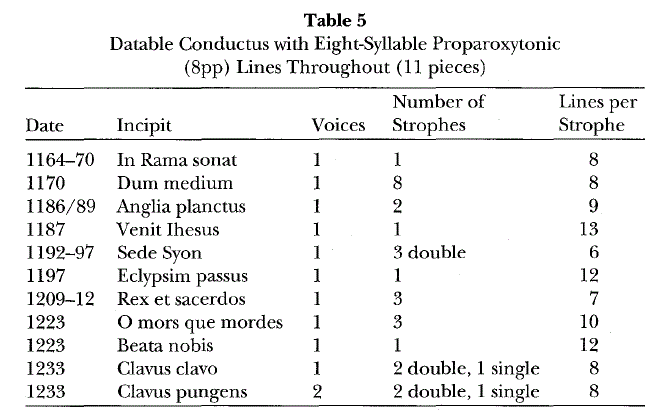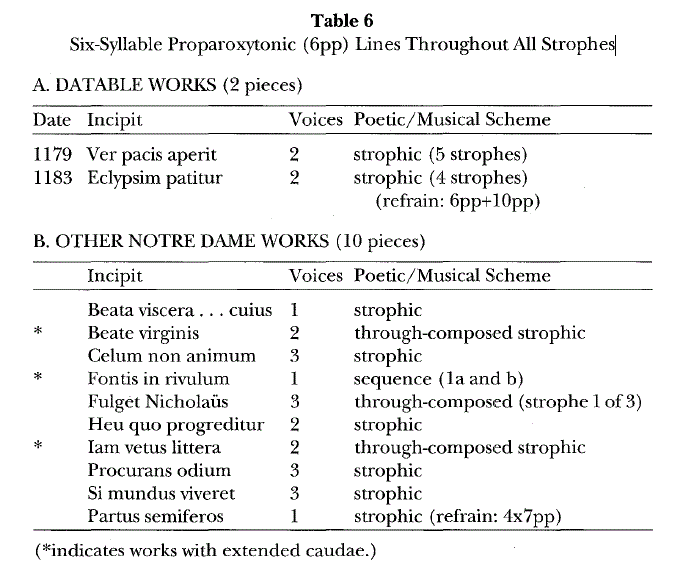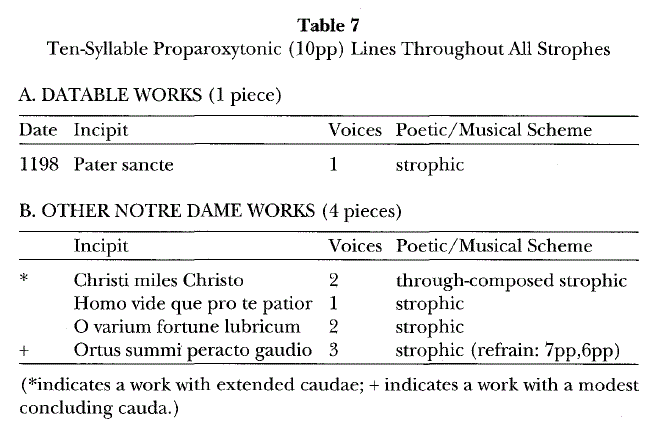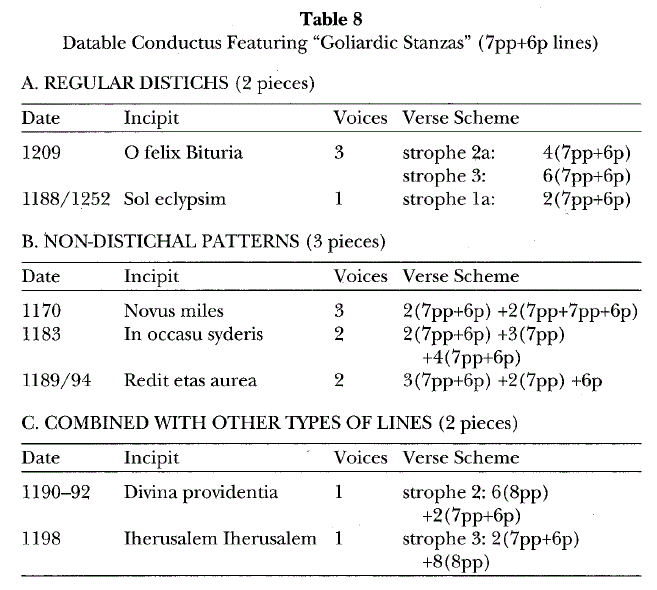|
●Datable "Notre Dame" Conductus: New
Historical Observations on Style and
Technique3
Verse Schemes
On a
slightly smaller scale, the construction and organization of the
individual lines of verse within a poem may likewise indicate
historicaltrends. Poetic verse schemes in the datable repertory exhibit
three major types. These comprise complete pieces or single strophes that
either contain 1) isosyllabic patterns, with the same number of syllables
per line appearing throughout the poem; 2) a series of distichs, in which
lines of only two different formations alternate regularly; or 3) less
uniform schemes with lines of two, three, or four different lengths. Of
all these types, the most informative is the first.
より小さな規模において、詩の中のverse個々の行の構築と機構は歴史的経緯を示すかもしれない。datableなレパートリーの詩のverse
schemesは、次の3つの基本タイプがある。これらは作品全体と詩句とから構成される。それぞれは以下のようである。
1) iso syllabic patterns(すべてにわたり、一行あたりのシラブルが同じ数)
2) a series of distichs(一連の2行連句)
3) less uniform
schemes(行の長さが異なる)
これらの中で、もっとも情報があるのは最初のものである。
Among the
isosyllabic schemes that occur in the datable conductus, the most common
example, with the greatest chronological sweep, is the eight-syllable line
with a consistent stress on the proparoxytone, or antepenultimate syllable
(8pp).20 By the time of the Notre Dame school, the 8pp line had the double
fortune of being both very old and extremely distinguished. In its
construction it recalls the quantitative classical iambic dimeter, the
very scheme that Saint Ambrose had used exclusively for introducing his
hymns to the Western church. In its rhythmic, accentual form it continued
as one of the most common patterns for the liturgical hymns of the Office,
and was especially popular in the north of France, where it attracted the
attention of the Notre Dame poets for their conductus and the trouveres
for their chansons (see Spanke 1936: 22, 23).
isosyllabic schemesの間では、datable conductusにおいて、もっとも一般的な例は、proparoxytoneあるいはantepenultimate
syllableに常時アクセントがある8シラブルの行である(8pp)。 ノートルダム楽派の頃まで、8pp行は非常に古く、非常に著明な二重の幸運に恵まれていた。その構造においては、それは定量的・古典的iambic
dimeterと、聖アンブロシウスが西方教会に彼の賛歌を導入するために排他的に使ったスキームを想起させる。そのリズムとアクセントの形において、それは、聖務日課における典礼賛歌のためのもっとも一般的パターンの一つとして続いていた。そして、北フランスでは特にポピュラーであった。そこでは、それはノートルダム楽派の詩人たち(彼らのconductusのために)やtrouvereたち(彼らのchansonのために)の注意を挽いた。
As a result of its wide acceptance, the use of 8pp lines in the datable
conductus provides no overt chronological trends, except for its persistence
throughout the corpus (see table 5). The exclusive use of the line for
an entire poem occurs in eleven texts within the datable conductus repertory.
その広い受け入れの結果、datable conductusにおける8pp行の利用は、明白な時系列的な傾向を作っていない (see table 5)。詩全体の行に対する排他的な利用(8ppばかりにする)は、datable conductusのレパートリーのうちの11のテキストにおいて見られる。
Three are strophic sequences, four others are single stanzas, and the rest
are regularly strophic. There is likewise no consensus among them as to
a favored number of lines per strophe or number of strophes per poem. The
chronological boundaries of the 8pp pieces are similarly extensive. They
range from the earliest datable conductus, In
Rama san at gemitus (1164-70), to the two Holy Nail lyrics of 1233,
Clavus clava retunditur and Clavus pungens acumine. In
addition to these works, 8pp lines also appear as the sole component of
several specific strophes in three other through-composed datable poems,
two from the twelfth century and the third probably composed as late as
1252.21
3つは有節 sequencesであり、他の4つは単一スタンザであり、残りは規則的有節である。ひとつの節あたりの行数やひとつの詩あたりの節の数には特にコンセンサスはない。8pp作品の時系列的境界は、同様に拡大している。それは、初期のdatable
conductusIn Rama san at gemitus (1164-70) から1223年の2つのthe two Holy Nail lyricsであるClavus clava retunditur とClavus pungens
acumine.まで拡大している。こうした作品に加えて、8pp行はまた、3つの他の通作datable
poem(2つは12世紀の、3番目は遅くとも1252年には作られている)におけるいくつかの特殊な節の唯一の構成要件として存在もする。

Isosyllabic strophes with proparoxytonic lines of
seven syllables (7pp) are likewise chronologically diverse, although not
as numerous as the eight-syllable type.22 Somewhat more informative for
suggesting chronological tendencies is the role played by poems composed
solely of six syllables with an antepenultimate stress (6pp).23 This
particular scheme recollects the design of alexandrine verse, a pattern
associated especially with Old French epic poetry consisting of a
twelve-syllable line with a marked caesura after the sixth syllable.
During the course of the twelfth century, notably in some of the hymns of
Peter Abelard, the caesura became increasingly emphasized by rhyme, which
divided the line in half and led to the more common 6pp form found in the
Notre Dame conductus repertory.
Isosyllabic strophe with proparoxytonic lines of seven syllables (7pp)
は、時系列には多様である。8ppほど多くの作品はないけれども。幾分でも有用な時系列的傾向は、six
syllables with an antepenultimate stress (6pp)から作られた詩が果たす役割である。この特殊なスキームは、アレクサンドランverseのdeisignを再収集し、パターンは特に、古フランスの叙事詩(12シラブル行からなっていて、6行の後にcaesuraが入る)と関連している。12世紀には、アベラールの詩が有名であり、caesura(中間休止)は次第に韻によって強調されるようになり、行を半分に分割し、ノートルダム楽派のconductusレパートリーにおいて見出される6pp形をより一般的にするようになった。
Two
datable works composed solely of 6pp verses appear in the conductus
repertory. They are the coronation song Ver pacis aperit from 1179
and the planctus Eclypsim patitur of 1183, which varies from a
constant 6pp scheme only once in its refrain. 24 Besides Ver
pacis and Eclypsim patitur, 6pp lines are also prevalent in the
first and second strophic pairs of the 1181 monophonic lament Omnis in
lacrimas. 25 From this evidence, the exclusive use of 6pp lines in a
conductus stanza offers the possibility that such works may issue from the
last two decades of the twelfth century.
6pp
verseで唯一作られた2つのdatable作品がconductus レパートリーにおいて明らかである。それらは、戴冠式の歌であるVer
pacis aperit(1179) とEclypsim
patitur(1183)である。両作品の他には、6pp行は1181年の単声lament Omnis in
lacrimasの第1、2節のペアにおいて見出される。こうした事実から、conductusスタンザにおける6ppの独占的な使用は、こうした作品が12世紀の最後の20年間からのものであった可能性を示唆する。
This interpretation has
been strengthened by the research of Janet Knapp (1979), who has
specifically investigated six polyphonic conductus that have exclusive, or
nearly so, 6pp verse schemes.26 She has found that these compositions
exhibit a closely related musical style and a notational consistency that
she applies to the vexing question of their rhythmic performance. A
further perusal of the entire Notre Dame conductus repertory reveals a
total of twelve examples that rely exclusively on 6pp lines for either their entire verse
scheme or for the complete content of specific strophes (see table 6).27
こうした解釈は、特に、独占的かそれに近いような6pp verseを持つ6つのポリフォニックなconductusを調査したJanet
Knappの研究によってはっきりしてきた。彼女は、こうした作品が密接に連関した音楽形式とリズム上のやっかいな疑義を呈している記譜上の一貫性を持つことを明らかにした。ノートルダム楽派のconductusのレパートリーのさらなる研究は、それら全体のverseスキームあるいは特殊な詩句の完璧な内容が6pp行に依存している全部で12の例を明らかにした。
Only three of these pieces
(Beate virginis, Fantis in rivulum, and lam vetus littera) diverge
significantly from the simpler styles of Knapp's "early layer"
compositions by presenting extensive melismatic interludes throughout
the course of each work. These observations imply that the bulk of the
6pp conductus repertory-those
pieces that correspond stylistically to the datable Ver pacis aperit
(1179) and Eclypsim patitur (1183)-were also likely composed before 1200, and that the use of
an iso syllabic 6pp verse structure did not make great inroads in the
development of the more complex, melismatically suffused works associated
with the thirteenth-century datable repertory.28
3つの作品
(Beate virginis, Fantis in rivulum, and lam vetus littera)のみが、
Knapp'の "初期" 作品のより単純なスタイルから発散することになる。こうした観察は、6pp donductusレパートリー(スタイル的に datable Ver pacis aperit (1179) and
Eclypsim patitur (1183)に相当する)の大部分が1200年以前に作られたものであろうこと、、isosyllabic 6pp
verse構造の利用が、より複雑でメリスマに覆われた作品(13世紀のdatableレパートリーに関係している)の発展段階に大いに関わっていることを明らかにしている。

Closely related to the 6pp verse, both in its
structure and in its isolated use in the conductus repertory, is the line
of ten syllables with a final proparoxytonic accent (10pp). This specific
linear scheme is also prominent in vernacular literature, both in Occitan
and Old French, and was especially favored for the chanson de geste.29 The
10pp line as used in Notre Dame conductus nearly always features a caesura
after the fourth syllable, which suggests that it may be easily and
conveniently viewed as a 6pp line introduced by a four-syllable unit. 30
Indeed, the relationships between these two types of lines may extend
beyond their structural similarities, since their use throughout the
conductus repertory suggests a chronological proximity as
well.
6pp verseに関係して、conductusのレパートリーにおけるその構造や隔離した使われ方において、両者はfinal proparoxytonic accentに関連した10の音節を持つ行である。この特殊な行のスキームはまた、オック語と古フランス語といった世俗文学において傑出している。ことにchanson de geste(武勲詩)への嗜好があった。ノートルダムのconductusにおいて使われた10ppの行は、4番目の音節のあとにほとんど常にcaesura(中間終止)がある特徴がある。それは便宜上、4音節ユニットで誘導された6pp行として見える。こうした2つのタイプの行の間の関係は、構造的類似性をはるかに凌駕している。なぜなら、conductusレパートリーを通したこうした利用は、時系列的な近接をよく示すからである。
Isosyllabic
texts of 10pp lines occur only five times in the conductus from Notre Dame
sources (see table 7) and the only datable representative is Philip the
Chancellor's encomium to Innocent III, Pater sancte dictus Lotarius
(1198). Of the other examples, the two-part
0
variumfortune lubricum and Philip's
monophonic Homo vide que pro te patior share with Pater sancte and the majority of the isosyllabic 6pp works an unpretentious musical
style, with sections devoted to caudae notably absent.
10ppのIsosyllabicなテキストはノートルダム楽派のconductusにおいて、5回だけ現れる
(see table 7)。そして、唯一のdatableな代表が、Philip the Chancellorの Innocent
3世への賛辞Pater sancte dictus Lotarius (1198)である。こうした例のうち、2声の0
variumfortune lubricumとPhilip作の単声のHomo vide que pro te
patiorはPater sancte とisosyllabicな6ppの作品の大部分と、特にcaudaeを持たない部分とで目立たない音楽様式を共有している。

The two exceptions are the
three-part Ortus summi peracto gaudio, which possesses only a modest closing melisma, and the strikingly different Christi miles Christo quo
militat, a composition for
two voices that brandishes extensive, musically sophisticated caudae at
the beginning and end of each of the five 10pp couplets that make up its
strophes. The consistency in style, however, of the
other, plainer decasyllabic conductus
suggests that these poems may hail from around the same time as Pater
sancte (1198).
ふたつの例外は、3声のOrtus
summi peracto gaudio(控えめな終止時におけるメリスマを持つ)とそれとはまるで異なったChristi miles
Christo quo
militat(2声作品で、その詩句を作る5組の10ppの最初と最後に洗練されたcaudaeがついている)である。より平易なdecasyllabic
conductus(10pp)は、こうした詩が、Pater sancte
(1198)と同じ時期に作られたことを示す。
With the additional evidence of a connection
between the form and style of works with proparoxytonic lines of ten and
six syllables, it is even tempting to suggest a time of composition one or
two decades earlier than Pater sancte for most of the 10pp works.31
Except for the advanced Christi miles, then, the sparse number of
such conductus and their prevailing stylistic simplicity argue for a
period of cultivation principally before the turn of the
century.32
10,6音節の最後から3番目の行中の作品の形式や様式の間の結合の付加的証拠とともに、大部分の10pp作品に対して、
その作曲時期が、Pater
sancte よりも10〜20年ほど早かったと考えることは誘惑的でさえあるだろう。Christi
milesを除き、こうしたconducutus数の数の少なさと形式的単純性の優先は、世紀の代わり目以前に、その開拓期間を論じることになる。
Strophes composed of regular chains of distichs are
rare in the datable repertory and by themselves do not provide ready means
for chronological arrangement into earlier or later practices, even when
bolstered with additional datable works that use a less rigorous series of
the same two-line units or by a survey of the entire body of Notre Dame
conductus. Two different and representative types of such strictly
alternating patterns are especially prominent.
二行連句の規則的なつながりにおいて作られた節は、datableレパートリーにおいては稀である。そして、それ自体では、より厳しくない同じ2行ユニットシリーズあるいはノートルダム楽派conductus全体の精査によったシリーズを使う付加的なdatable作品を強化した時でさえも、より早期または後の実践への時系列的な準備手段を提供しない。こうした厳密な交代パターンの二つの異なった、代表的タイプは特に明らかである。
As with the
relationship between the alexandrine and 6pp designs signaled above, both
first formed a series of longer lines that were eventually split into two
unequal units through the increasing demarcation of a fixed
caesura (as well as the end of
the line) through rhyme. One of the two schemes
consists of fifteen syllables divided into 8p+ 7pp; the other presents
thirteen arrayed as
7pp+6p.
アレクサンドランと6ppとの関係において述べたように、最初に形成された二つのより長い行の連続は、韻を通して、増加する固定したcaesuraの境界によって、最後は二つの長さの異なるユニットに分裂する。二つのスキームのうちの一つは、7ppと8ppに分けられる15音節からなっている。他のものは13音節で、7ppと6pに分けられる。
The
former of the two is unquestionably the older. Whatever its debt to
quantitative classical metrics may be, it appears prominently in early
church hymns, and is perhaps best known as the scheme of Pange lingua
gloriosi proelium certaminis by Venantius Fortunatus (ca. 540-ca.
600).33 Strikingly, the one datable example that faithfully follows this
fifteen-syllable pattern, Pange melos lacrimosum of 1190,34
actually evokes the precedent of the older hymn in its opening
word.
2つのうちの前者は、疑いなくより古い。それがどれほど定量的古典的基準に負っていようが、それは初期の教会参加において明らかである。そしておそらくは、Venantius
Fortunatus (ca. 540-ca. 600)によるPange lingua gloriosi proelium
certaminisのスキームとしてもっともよく知られている。印象的なことには、あるdatableな例は実際の開かれた言葉の古い賛美歌の先例を思い起こさせる。
The
obstacles to using the 8p+ 7pp line for assessing the chronology of Notre
Dame conductus seem clear. Spanke cites two other such works that use both
the same form and rhyme scheme as Pange melos:Fraude ceca
desolato and Hec est dies triumphalis, both of which are
heavily melismatic works that probably issue from the 1200s. He also
reveals the additional employment of the fifteen-syllable distich in
conductus from before the turn of the century in Alain de Lille's
Exceptivam actionem and in a poem without a surviving melody by Walter
of Chatillon (Spanke 1936: 27-28). Other, less regular occurrences of this
pattern within the datable repertory add little additional support. They
show that individual stanzas using the elements of the 8pp+ 7p model range
all the way from the twelfth-century Omnis in lacrimas (1181) to
portions of A urelianis civitas
(1236).35
ノートルダム楽派conductusの年代史を評価するための8p+7p行の使用への障害は明らかである。SpankeはPange
melos:Fraude ceca desolato と Hec est dies
triumphalis(両者ともおそらくは1200年代の非常にメリスマティックな作品である)の両者が、おそらくは1200年代に作られた非常にメリスマ的な作品であるとして、両方とも同じ形と韻のスキームを使う二つの別の作品を引用している。彼はまた、15音節の二行連句(conductusとしては世紀の変わり目前のAlain
de LilleのExceptivam actionem からの、詩としてはWalter of Chatillonのもの)の付加的使用を明らかにしている。他に、datable レパートリーにおいてはそれほど起こらないことはほとんど付け加わることはない。8p+7pモデルの要素を用いる個々のスタンザは、12世紀のOmnis
in lacrimas (1181)からA urelianis civitas
(1236)の一部分までを駆け巡るのである。
The second instance of reiterated two-line
chains in the datable conductus repertory appears not only to be a more
recent phenomenon than the fifteen syllable design of Pange melos
lacrimosum, but also is instructive because the datable items seem to
contradict the evidence of the conductus repertory at large. The
thirteen-syllable distich of 7pp+6p is more generally known as the
"goliardic measure," so called from its frequent use in Latin poems
with secular and profane themes.36
datable condustusレパートリーにおける繰り返す2行のつながりの第2の例は、Pange melos
lacrimosumの15音節のデザインより最近の現象として見られるだけでなく、有益でもある。なぜならば、datableな項目はconductusレパートリーのevidenceに矛盾するように見えるからである。13シラブルの7p+6pの二行連句はより一般的には"goliardic measure,"として知られている。それは、ラテン語詩において、たびたび世俗や不倫をテーマにするからそう呼ばれているのである。
Although several isolated
examples of this line have been traced back to as early as the fourth
century, it was not until the middle of the twelfth that it truly
blossomed and became one of the most prevalent of the verse forms of its
time. It is especially closely associated with Walter of Chatillon, and
several of his poems in this arrangement are preserved with music in Notre
Dame manuscripts.37
この行のいくつかの別々の例が4世紀にまで遡って見られるが、それが花開き、時代のverseの形式にもっともふさわしいもののひとつとなったのは、12世紀半ばになってからであった。それはことにWalter
of Chatillonと結び付けられ、そして、こうした形式の彼の詩は、ノートルダム写本では音楽とともに保存されている。
The
datable conductus repertory argues for the most concentrated use of the
goliardic measure before 1200. Only two works, 0 felix Bituria
(1209) and Sol eclypsim patitur (1188/1252), give evidence of the
implementation of the thirteen-syllable unit after the turn of the
century. Both of these pieces are also singular in presenting their texts
in regular distichs.
datable conductusレパートリーは、1200年以前においては、 goliardic
measureの利用の集中度具合で論じられていた。唯一の二つの作品、0 felix Bituria (1209) と Sol
eclypsim patitur (1188/1252)は、世紀の変わり目以降の13シラブルユニットの実用化の例となる。これら両方の作品はまた、規則的な二行連句においてそのテキストの提示において特異的でもある。
All the other datable examples of the scheme, which either feature a
more varied configuration of the lines or mix the goliardic pattern with
other verse forms, point to the twelfth century (see table 8). However, this apparently pointed
chronological information does not conform to the evidence presented by
the complete body of Notre Dame conductus. No less than twelve undated
examples with goliardic measure appear in the central Notre Dame manuscripts.
Three of these works, Flos in monte cernitur, Ave virgo virginum, and
Quid tu vides jeremia, do conform to the unadorned musical style
already associated with the earlier layer of the corpus, but a further
nine pieces are more elaborate, melismatically rich compositions that
probably issue from the thirteenth
century.38
すべての他のdatableなスキームの例(どちらもよりさまざまな行の構成であり、あるいは他のverse形式とともにgoliardic patternを混ぜている)は12世紀のものである(see table 8)。しかしながら、時系列的情報から明らかになったことは、ノートルダムconductusの完全な具体化によって存在する証拠を確信することではない。goliardic
measureを伴う、作成日付が明らかでない12以上の例は、ノートルダム楽派写本の中心において見られる。こうした作品のうちの三つ、Flos
in monte cernitur, Ave virgo virginum, Quid tu vides
jeremia,は、すでに早期の作品層と関連した手つかずの音楽形式を確信する。しかし7以上の作品は、おそらくは13世紀から出現した、より丹精が込められたメリスマが多い作品である。

Far from being silent, then, the structures of the
poetic texts in the datable repertory can provide some telling means for
inquiry into conductus style. Not only do the various strophic designs of
the works furnish perspectives for clarifying the development of the
genre, but even the use of certain poetic schemes in the verse of these
specific pieces can offer information for the outlining of trends within
the Notre Dame school. As these compositions demonstrate, investigations
of their texts as well as their music are essential tools in any attempt
to unravel the musical history of the
conductus.
datableレパートリーの詩のテキストの構造は、conductus形式の精査のためのいくつかの伝達手段を提供することができる。作品のさまざまな詩句のデザインが分野の発展を明らかにするための視線を備えるだけでなく、この特殊な作品のverseのある種の詩のスキームがノートルダム楽派内の傾向の概要にたいする情報を提供することができる。こうした作品が示すように、テキストの調査は音楽のそれと同様、connductusの音楽的歴史を明らかにする試みのための本質的な道具なのである。
|